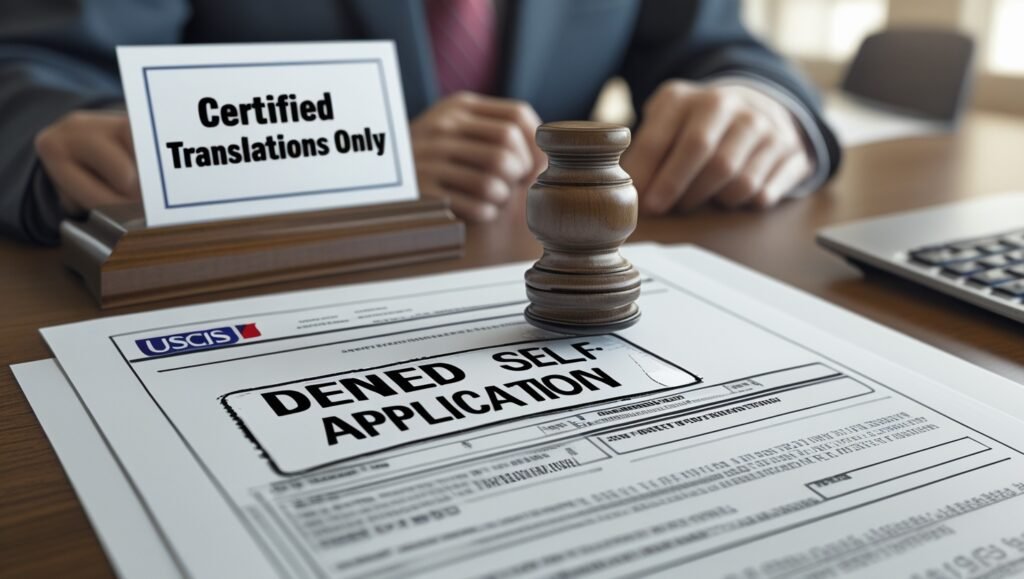When You Can (and Can’t) Translate Documents Yourself: A Simple Guide

Have you ever stared at an important document in another language and thought, “I could just Translate Documents Yourself”? You’re not alone. With our busy lives and tight budgets, the idea of doing our own translations seems pretty appealing. After all, why pay someone else when you speak both languages fluently?
Well, hold on a minute. While translating documents yourself can work in some situations, it can also land you in serious trouble in others. Let me walk you through when it’s okay to be your own translator and when you absolutely need to call in the professionals.
The Big No-No: USCIS and Immigration Documents
Let’s start with the most important rule: If you’re dealing with USCIS (U.S. Citizenship and Immigration Services), forget about translating documents yourself. Period. End of story.
I know this might sound harsh, but USCIS doesn’t care how fluent you are in both languages. They have strict rules, and breaking them can seriously mess up your immigration case.
What USCIS Actually Requires
When you submit documents to USCIS, here’s what they want:
- A complete English translation of your document
- A signed certificate from the translator stating that the translation is accurate and complete
- Proof that the translator is competent in both languages
The translator doesn’t need to be officially certified, but here’s the catch: it absolutely cannot be you or anyone directly related to you (like your spouse, parent, or sibling).

Documents That Need Professional Translation for USCIS
Think about all those important life documents you might need for immigration:
- Birth certificates
- Marriage or divorce certificates
- Driver’s licenses and IDs
- Criminal background checks
- Bank statements and financial records
- Educational transcripts
- Medical records
Every single one of these needs to be translated by someone else if you’re submitting them to USCIS. No exceptions.
When You CAN Translate Your Own Documents
Now for the good news! There are plenty of situations where translating documents yourself is not only allowed but actually makes perfect sense.
Personal and Informal Use
If you’re translating documents for your own understanding or for informal sharing, go for it! This includes:
- Personal letters and emails from family or friends
- Your resume and cover letter for job applications
- Travel confirmations and booking details
- Meeting notes and internal company communications
- Academic research papers you’re reading for personal interest
- Draft translations that you’ll later have professionally done
The key here is that these documents aren’t being submitted to any official agency or used in legal proceedings.
Using Translation Tools Like Smallpdf
If you decide to translate documents yourself, you don’t have to do it word by word with a dictionary. There are some pretty neat tools out there that can help.
Take Smallpdf’s Translate PDF feature, for example. It’s actually quite handy for personal use:
What it can handle:
- PDF files (obviously)
- Word documents
- Excel spreadsheets
- PowerPoint presentations
How it works:
- Upload your file
- Choose between a quick summary or full document translation
- Pick your source and target languages
- Hit translate
- Download your translated document
The cool part? It keeps your original formatting intact, so your translated document doesn’t look like a mess.
The important part? This is perfect for understanding content or creating drafts, but it’s not suitable for official submissions.
Beyond USCIS: Other Times You Need Certified Translations
USCIS isn’t the only organization that’s picky about translations. You’ll likely need professional translations for:
- Court documents and legal filings
- University applications and academic transcripts
- Embassy submissions for visas
- Medical records for insurance claims
- Official business contracts
Think of it this way: if the document is going to an official organization that could make important decisions based on it, you probably need a certified translation.
Quick FAQ: Your Most Common Questions Answered
Q: Can I translate my own birth certificate for USCIS? A: Nope. USCIS requires all translations to come from a neutral third party with a signed certificate.
Q: What about using Google Translate or ChatGPT for official documents? A: These tools are great for understanding content, but they’re not acceptable for legal or official submissions. You need a human translator who can certify the accuracy.
Q: Can I translate documents for my spouse’s immigration case? A: No, family members can’t translate documents for immigration cases. You’re considered too close to the applicant to be neutral.
Q: Are there any exceptions to the USCIS rule? A: Very rarely. Some documents that are already in English but from another country might not need translation, but when in doubt, always check with an immigration attorney.
Q: What exactly is “self-translation”? A: It simply means translating your own documents rather than hiring someone else to do it. It’s perfectly fine for personal use but not for official submissions.
Making the Right Choice
Here’s a simple way to think about it:
Translate it yourself if:
- It’s for your personal understanding
- You’re creating internal company documents
- You need a quick draft to understand the content
- Nobody’s making official decisions based on the translation
Get professional help if:
- You’re submitting it to any government agency
- It’s for legal proceedings
- A school or university requires it
- Your insurance company needs it
- An embassy or consulate wants it
The Bottom Line
Look, I get it. Professional translation services can be expensive, and when you’re already stressed about paperwork and deadlines, the last thing you want is another bill. But think of certified translations as insurance for your important applications.
For everything else? Tools like Smallpdf’s translator can be incredibly helpful. They’re fast, they keep your formatting clean, and they’re perfect for those times when you just need to understand what a document says or create a working draft.
The key is knowing when to DIY and when to call in the pros. Get it wrong with USCIS or other official agencies, and you could face delays, rejections, or worse. But for personal use and informal situations, translating documents yourself can save you time and money.
What’s Next?
If you’re dealing with immigration documents, don’t risk it – find a qualified translator who can provide the certification you need. For everything else, feel free to give DIY translation a try.
And remember, when in doubt, it’s always better to err on the side of caution. A small investment in professional translation now can save you from much bigger headaches later.
Need to translate documents for personal use? Try tools like Daily Multi Tools Translate PDF for quick, formatting-friendly translations. For official submissions, always consult with certified translation services.

